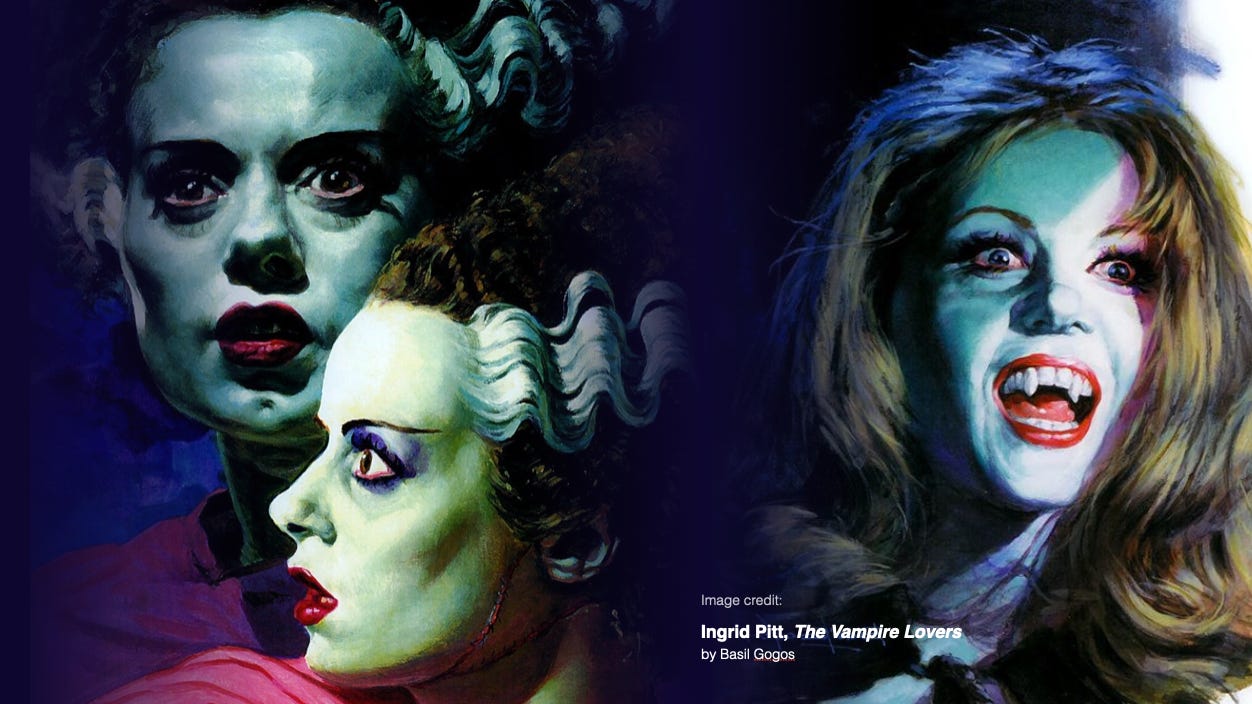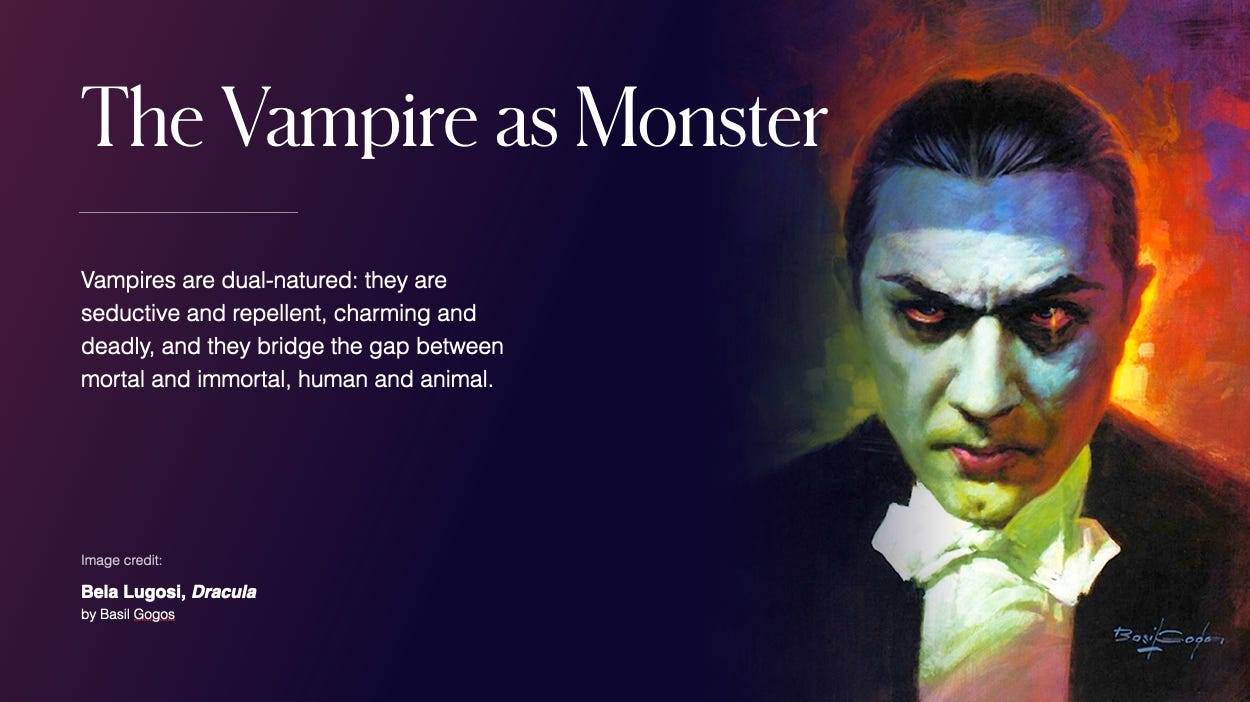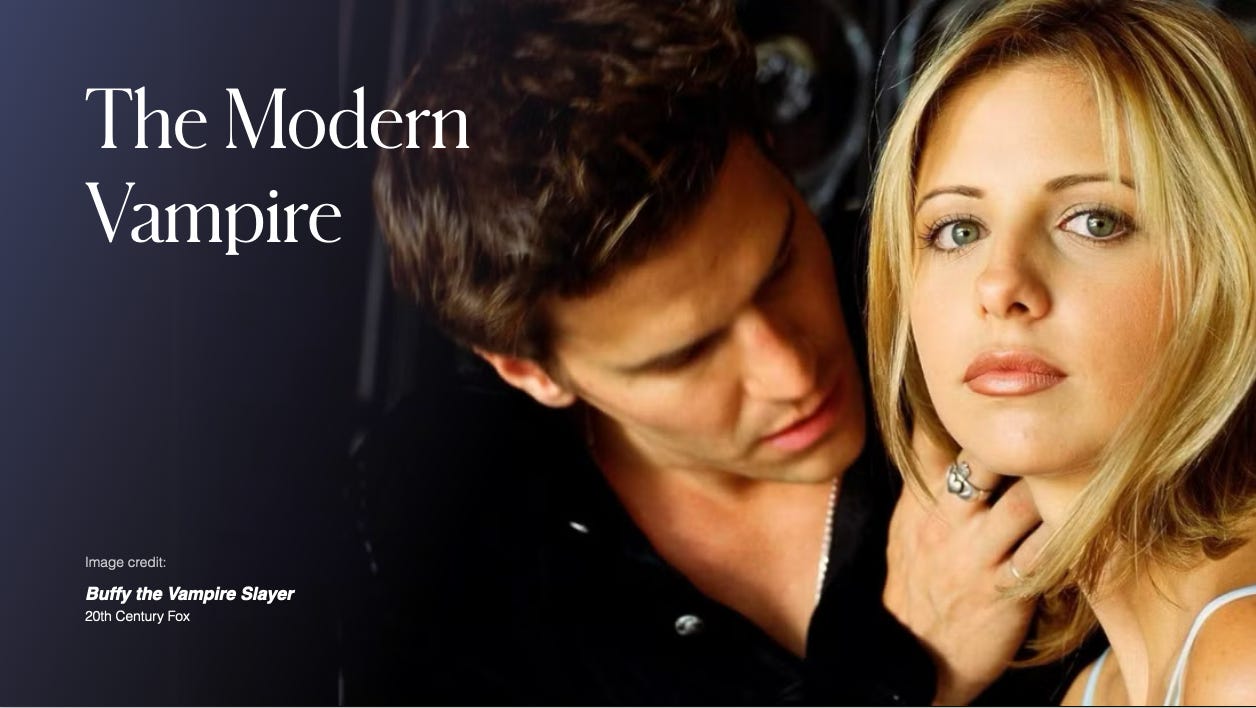The Hungry Shadow: Facing the vampire within (Menaces of the Mind #4)
The inner mechanics of slow depletion – this is how to revive your energy, passion and drive
You can listen to this story on YouTube, or read on below.
***
Sometimes, the monster doesn’t roar, but whispers, charms, and seduces, and before we know it, a little of our life has been drained away.
This article is for anyone who ever feels depleted of energy, vibrancy, or zest for life – anyone who’d like to rediscover their authentic spirit – because we’re inviting a very old, very hungry archetype into the light: the Vampire.
The legend of the vampire
Vampires are everywhere – from the demons of ancient Mesopotamia to Bram Stoker’s Dracula, the modern-day glittering immortals of Twilight and the slightly earlier, but obviously far superior, bloodsucking fiends slain by Buffy.
While this monster has shapeshifted across time and culture, it has clung on with slender fingers to the same core themes of shadowy allure and death by slow depletion, which is perhaps why this ancient monster has us so enthralled. The Vampire shows us what happens when we lose touch with our own vitality. Because what we exile doesn’t die – it waits, and drains us, silently, from the dark.
The vampire as monster
As with all archetypes and all good monsters, vampires are dual-natured: they are seductive and repellent, charming and deadly, and they bridge the gap between mortal and immortal, human and animal. Internally, they bridge the gap between conscious and unconscious.
As undead, the Vampire cannot sustain itself because it needs something it can’t create for itself: blood. In terms of archetypal symbolism, blood is the emotional, active, connected energy within us. It is vitality, creative power and love, lust and libido, too. All of this comes together to make a monster inherently connected to the purest of energies: life force.
In psychological terms, then, this monster serves as a potent metaphor for both inner and outer dynamics that drain our joie de vivre, or lure us into parasitic cycles of perpetual dissatisfaction.
The good news is that this means that we can use the Vampire as a seductive symbolic vehicle for identifying and ultimately disentangling ourselves from the unconscious patterns and habits that keep us feeling drained, powerless, dependent or simply unable to step into the light of day.
The Vampire as split-off
Marie-Louise von Franz talks about the psychic vampire as a split-off part of the personality. The example she gives is the split-off anima, which is the archetype of the inner feminine soul or spirit. “When the anima is negative,” she says, “it is the impulse to dream about life and make wishful fantasies about life instead of living life”.
To have become vampiric, she goes on to say, this isolated complex (or rejected part of the personality) must have been split off so dramatically, so radically, that it can only sap energy away in secret – attacking under the cover of darkness, leaching the life blood out of us, and leaving us listless, unmotivated, tired, depressed and with an enduring sense that nothing means anything anymore.
To someone who comes to analysis with these complaints, she says – and I always enjoy von Franz’s shockingly blunt honesty in these kinds of accounts – “we could answer them: you are probably being sucked by a vampire. You are bloodless. You have no life impulse, no pleasure in life anymore, no interests or anything.” Ouch!
Vampire movies are so popular, says von Franz, because they are our modern version of folklore or fairytales, and the stories that capture us – old and new – are the ones that “tell about the inner world”. We need an orientation, she says; a way of “mapping out the dreamworld and the unconscious”, and the vampire motif is an age-old means for doing this.
Vampires in modern culture
Today’s vampire stories often glamorise the monster.
Think Interview with the Vampire — beautiful, immortal beings who ache for the connection they can never truly have. We watch the challenging love affairs between human and vamp – Buffy and Angel, Buffy and Spike, Sookie and Bill, Bella and Edward – and our hearts break over and over.
Another reason for the Vampire’s longevity as a narrative symbol is that we all know that hunger. We feel it every time we let a fundamental part of ourselves slip into the shadows, leaving us with an eternally unfulfilled longing for intimacy or connection, wholeness, creativity, whatever. The Vampire tries again and again to add in something it needs to find within itself in order to fully experience it – life blood, vitality, being.
External vampiric relationships are built on this same dynamic. They seduce by offering fulfilment, but what they actually deliver is codependency, conflict, and hurt. And when in a draining relationship of any kind, part of us knows this, right? Yet, we keep going back for more, addicted to the rush of blood, the thrill of almost tasting what we aren’t supposed to touch.
Although this isn’t always the case – because some abusive relationships truly are one-sided – there is often a parallel between inner and outer Vampires. The inner Vampire, as a split-off part of the personality that drains us and disconnects us from our authentic spirit, gets reflected in the draining external relationships that we form when unable to fully access our own life blood.
The vampire as shadow
“The shadow, when it is realized, is the source of renewal; the new and productive impulse cannot come from established values of the ego. When there is an impasse, and sterile time in our lives—despite an adequate ego development—we must look to the dark, hitherto unacceptable side which has been at our conscious disposal.”
― Connie Zweig, Meeting the Shadow: The Hidden Power of the Dark Side of Human Nature
Ultimately, the inner Vampire shows up when something essential inside us is perpetually starving – as an immortal, the Vampire does not grow, change or die; it is frozen in time, and locked into its pattern of hunger and unfulfilment. Its motivation is valid, therefore, and its intentions are good, but its means are disconnected, unhealthy, unhelpful and unconscious. The Vampire, of course, can’t see itself in the mirror – it knows not what it does.
This monster needn’t be limited to von Franz’s vampiric anima, though. Really, any exiled aspect of the psyche can be viewed through the lens of this archetype, because once split off, it will be forced to feed in the dark. Whatever its origin, it will sap something away.
The inner Vampire may be active when we people-please to the point of self-erasure because the fragile validation it yields feels like nourishment when self-worth is at a deficit.
When we feed on drama, crisis, or chaos because the intensity mimics aliveness when true passion or purpose are missing.
When we scroll endlessly or numb with consumption because something inside us is desperate to feel, but we don’t trust what might surface if we allow it to actually do that.
However it feeds, whatever it takes from us, in order to heal, the vampiric part must be brought into the light, where its parasitic tendencies burn away and the fundamental energy it’s made of can be invited – only ever invited – back in.
Consciousness as cure
So, the antidote to this monstrous threat isn’t a wooden stake after all. It’s awareness.
When we become aware of the ways in which we drain or are drained, we can start to understand what it is that we lack, and then how to actually satiate those needs.
We can ask:
Where am I giving out of depletion instead of abundance?
Who or what is draining my energy rather than fuelling it?
Where do I need to choose vitality over survival?
What do I search for in the outside world that I really need to find within?
And, most importantly, What am I truly hungry for?
Allow a part of your mind to consider this idea now: if there were an aspect of you that feels bloodless, which part would that be, and what is it hungry for exactly?
What’s missing for you? Is it connection, creativity, self-compassion? Is your inner Vampire starved of rest, play, belonging, truth, touch, purpose, freedom, wonder?
We need to let ourselves feel into the lack – to taste it, to define it – because when we can name our hunger, we can start to meet it consciously, and then we can stop living as prey to our own shadow.
It is not the quick fix this monster initially seems to promise, but awareness can, over time, transform the inner Vampire from a hidden predator into a conscious part of the psyche that we can nurture more fully and without harm – one that it’s safe to allow over the threshold.
The Vampire’s simplest message, when we dare to face it, is this: survival is not the same as living. To choose the latter is invariably challenging; it requires courage, acts of bravery, and honesty. But only when we take that challenge, can we step into the light of sovereignty, spirit and being.
Ultimately, the inner Vampire is only ever a part of the psyche that has forgotten how to feed itself in healthy ways. It may have been forced to forget, it may have been taught by people who weren’t able to face their own monsters, but whatever the reason for the forgetting, it can remember. So teach it, and you’ll be free, because what leeches in the dark is healed in the light of awareness.
References & Citations
Marie-Louise von Franz, The Anima and The Vampire
Connie Zweig, ‘Meeting the Shadow: The Hidden Power of the Dark Side of Human Nature’
Carl Jung, ‘The Archetypes and the Collective Unconscious’
Carl Jung, ‘Psychological Aspects of the Persona’
Marie-Louise von Franz, ‘Shadow and Evil in Fairy Tales’









